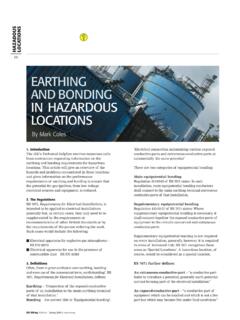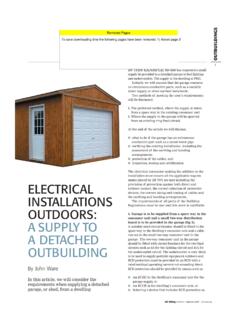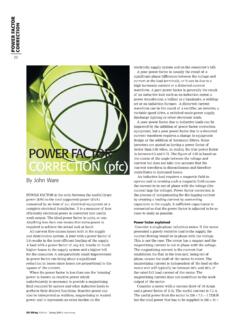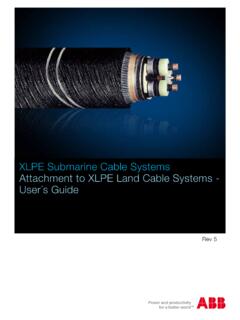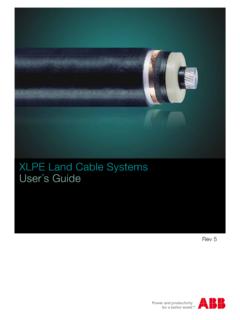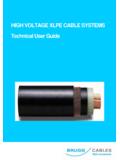Transcription of Appendix 4 of BS 7671 - BS 7671 Home of the Wiring …
1 Appendix 48 IET WiringMatters|Autumn08| THE correct cable for theapplication is imperative to ensure asatisfactory life of conductors andinsulation subjected to the thermaleffects of carrying current for prolongedperiods of time in normal the minimum size cross-sectional area of conductors isessential to meet the requirements for: Protection against electric shock(Chapter 41) Protection against thermal effects(Chapter 42) Overcurrent protection (Chapter 43), Voltage drop (Section 525), and Limiting temperatures for terminalsof equipment to which the conductorsare connected (Section 526).Current-carrying capacity andvoltage drop for cablesThe 17th Edition brought about somesignificant changes when calculatingthe current-carrying capacity andvoltage drop for cables.
2 For both the16th and 17th Editions, most of thecurrent ratings have been taken fromIEC 60364-5-52 and the CENELEC +A1 1998. These IEC andCENELEC documents do not,however, provide current ratings forarmoured single-core cables,therefore, the ratings for these cablesare based on data provided by ERAT echnology Ltd and the BritishCables tables have been updated toreflect present cable standards andintroduce current ratings for buriedcables. Generally, the current ratingsfor commonly used cables have notchanged between the 16th and methodsThe 16th Edition recognised 20methods of installation, the 17thEdition, however, recognises 57methods in Table 4A2. It is impossible,of course, to cover every possiblemethod or installation permutationbut, with the 17th Edition recognisinga further 37 methods of installation,more possibilities are now that all installation numbers intable 4A2 are different from those inthe 16th methodIt is impractical to calculate andpublish current ratings for everyinstallation method, since many wouldresult in the same current a suitable (limited) numberof current ratings have beencalculated which cover all installationmethods, known as ReferenceMethods.
3 There are 7 referencemethods, A to G, shown in table 4 of BS 7671by Mark ColesAppendix 4,Current-carryingcapacityandvoltagedrop forcablesandflexiblecords, has seen significantchanges with the publishing of bs 7671 :2008. Thisarticle looks at some of the changes and showsexamples of cable 410 IET WiringMatters|Autumn 08| methods of installationOther methods of installation arerecognised but are, essentially,variations of other methods and aretherefore allocated appropriatereference methods, shown in table is worth noting that the 17thEdition now references cables buriedin the ground (installation methods 70to 73). The current-carrying capacitiestabulated for cables in the ground arebased upon a soil thermal resistivity and are intended to beapplied to cables laid in and aroundbuildings, disturbed soil.
4 For otherinstallations, where investigationsestablish more accurate values of soilthermal resistivity appropriate for theload to be carried, the values ofcurrent-carrying capacity may bederived by the methods of calculationgiven in BS 7769 (BS IEC 60287) orobtained from the cable of installation methodRelevant table fromBS 7671:2008 ImageANon-sheathed cables in conduit in athermally insulated wallThe wall consists of an outer weatherproof skin,thermal insulation and an inner skin of wood orwood-like material having a thermal conductanceof at least 10 W/m .K. The conduit is fixed such thatit is close to, but not necessarily touching, the innerskin. Heat from the cables is assumed to escapethrough the inner skin only.
5 The conduit can bemetal or Method 1 of Table 4A2 Multicore cables in conduit in athermally insulated wallInstallation Method 2 of Table 4A2 BNon-sheathed cables in conduitmounted on a wooden ormasonry wallThe conduit is mounted on a wooden wall suchthat the gap between the conduit and the surface isless than times the conduit diameter. Theconduit can be metal or plastic. Where the conduitis fixed to a masonry wall the current-carryingcapacity of the non-sheathed or sheathed cablemay be Method 4 of Table 4A2 Multicore cables in conduitmounted on a wooden ormasonry wallInstallation Method 5 of Table 4A2C(clipped direct)Single-core or multicore cable on awooden or masonry wallNon-sheathed cables in conduit mounted on awooden or masonry wallInstallation Method 20 of Table 4A2 DMulticore unarmoured cable inconduit or in cable ducting in thegroundNon-sheathed cables in conduit mounted on awooden or masonry wallThe cable is drawn into a100 mm diameter plastic, earthenware or metallicduct laid in direct contact with soil having a thermalresistivity of and at a depth of values given for this method are those stated inthis Appendix and are based on conservativeinstallation parameters.
6 If the specific installationparameters are known (thermal resistance of theground, ground ambient temperature, cable depth),reference can be made to the cable manufactureror the ERA 69-30 series of publications, which mayresult in a smaller cable size being : The current-carrying capacity for cables laidin direct contact with soil having a thermal resistivityof and at a depth of m isapproximately 10 % higher than the valuestabulated for Reference Method DInstallation Method 70 of Table 4A2E, F and GSingle-core or multicore cable infree airThe cable is supported such that the total heatdissipation is not impeded. Heating due to solarradiation and other sources is to be taken intoaccount.
7 Care is to be taken that natural airconvection is not impeded. In practice, a clearancebetween a cable and any adjacent surface of atleast times the cable external diameter formulticore cables or times the cable diameter forsingle-core cables is sufficient to permit the use ofcurrent-carrying capacities appropriate to free Method 70 of Table 4A2 Table 1:Reference methodsAPPENDIX412 IET WiringMatters|Autumn 08| ,anappropriatereductionincurrent-carryin gcapacityshouldbemadeorthesoilimmediatel yaroundthecablesshouldbereplacedbyamores uitablematerial, , of cablesRelationshipof current-carryingcapacitytoothercircuitpa rametersTherelevantsymbolsusedintheRegul ationsareshowninTable3.
8 Theratedcurrentorcurrentsettingof theprotectivedevice(In)mustnotbelessthan thedesigncurrent(Ib)of thecircuit,andtheratedcurrentorcurrentse ttingof theprotectivedevice(In)mustnotexceedthel owestof thecurrent-carryingcapacities(Iz)of anyof theconductorsof thecircuit, current-carrying capacityof a cable for continuousservice, under the particularinstallation value of current tabulated inthis Appendix for the type ofcable and installation methodconcerned, for a single circuit inthe ambient temperature statedin the current-carrying design current of the circuit, current intended to be carriedby the circuit in normal service. Inthe rated current or current settingof the protective rated current or currentsetting of the operating current ( thefusing current or tripping currentfor the conventional operatingtime) of the device protecting thecircuit against rating factor to be applied wherethe installation conditions differfrom those for which values ofcurrent-carrying capacity aretabulated in this various rating factors are identified as follows.
9 CaCgCiFor ambient thermal operating temperature the type of protective deviceor installation ofinstallationmethodReference methodCable on a floorReference Method C applies for current rating under aceilingThis installation may appear similar to Reference Method C but because of the reduction in natural airconvection, Reference Method B is to be used for the current tray systemsA perforated cable tray has a regular pattern of holes that occupy at least 30% of the area of the base ofthe tray. The current-carrying capacity for cables attached to perforated cable trays should be taken asReference Methods E or F. The current-carrying capacity for cables attached to unperforated cable trays(no holes or holes that occupy less than 30% of the area of the base of the tray) is to be taken asReference Method laddersystemThis is a construction which offers a minimum of impedance to the air flow around the cables, metalwork under the cables occupies less than 10% of the plan area.
10 The current-carryingcapacity for cables on ladder systems should be taken as Reference Methods E or cleats, cableties and cablehangersCable supports hold the cable at intervals along its length and permit substantially complete free air flowaround the cable. The current-carrying capacity for cable cleats, cable ties and cable hangers should betaken as Reference Methods E or installed in aceilingThis is similar to Reference Method A. It may be necessary to apply the rating factors due to higherambient temperatures that may arise in junction boxes and similar mounted in the : Where a junction box in the ceiling is used for the supply to a luminaire, the heat dissipation fromthe luminaire may provide higher ambient temperatures than permitted in Tables 4D1A to 4J4A (seealso Regulation ).

